Construction of Earthquake Resistant Buildings: A Research Report
VerifiedAdded on 2023/06/03
|19
|3211
|352
Report
AI Summary
This report focuses on the construction of earthquake-resistant buildings, emphasizing the need to mitigate earthquake damage. It delves into the background of earthquakes, their measurement, and their impact on reinforced concrete structures. The report explores structural framing, requirements for structural safety, and various practices and technologies for low-cost earthquake-resistant construction, including the use of waste tire pads and rice/wheat straw buildings. The research methodology involves a review of secondary sources and the application of mathematical models. The study aims to provide a comprehensive understanding of earthquake-resistant building design and construction, offering valuable insights for engineers, architects, and policymakers involved in creating safer and more resilient structures. The report highlights the importance of understanding seismic waves and the behavior of structures during earthquakes, with a focus on the role of reinforced concrete frames and the significance of structural safety requirements. This report aims to provide a detailed analysis of the construction of earthquake resistant buildings.
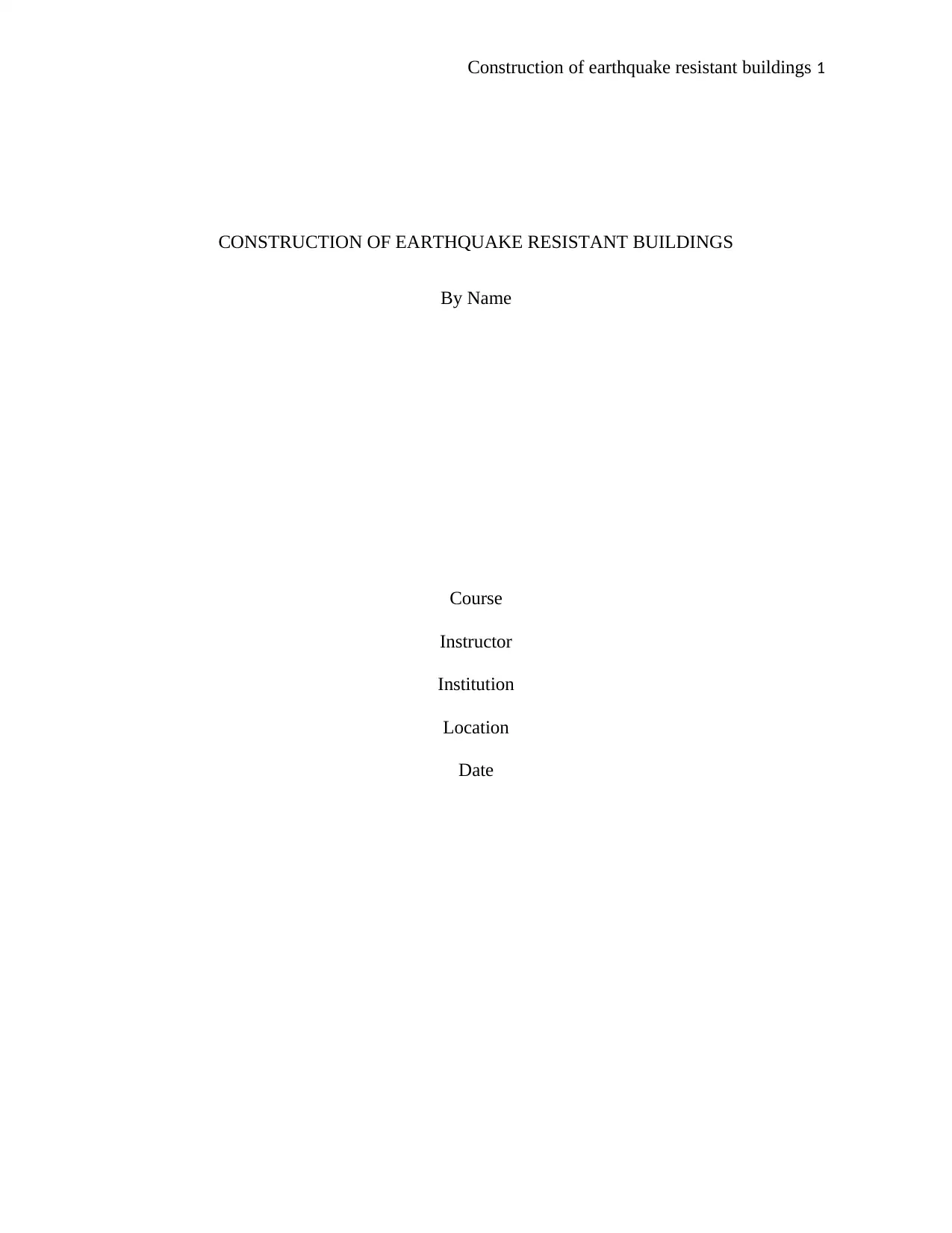
Construction of earthquake resistant buildings 1
CONSTRUCTION OF EARTHQUAKE RESISTANT BUILDINGS
By Name
Course
Instructor
Institution
Location
Date
CONSTRUCTION OF EARTHQUAKE RESISTANT BUILDINGS
By Name
Course
Instructor
Institution
Location
Date
Paraphrase This Document
Need a fresh take? Get an instant paraphrase of this document with our AI Paraphraser
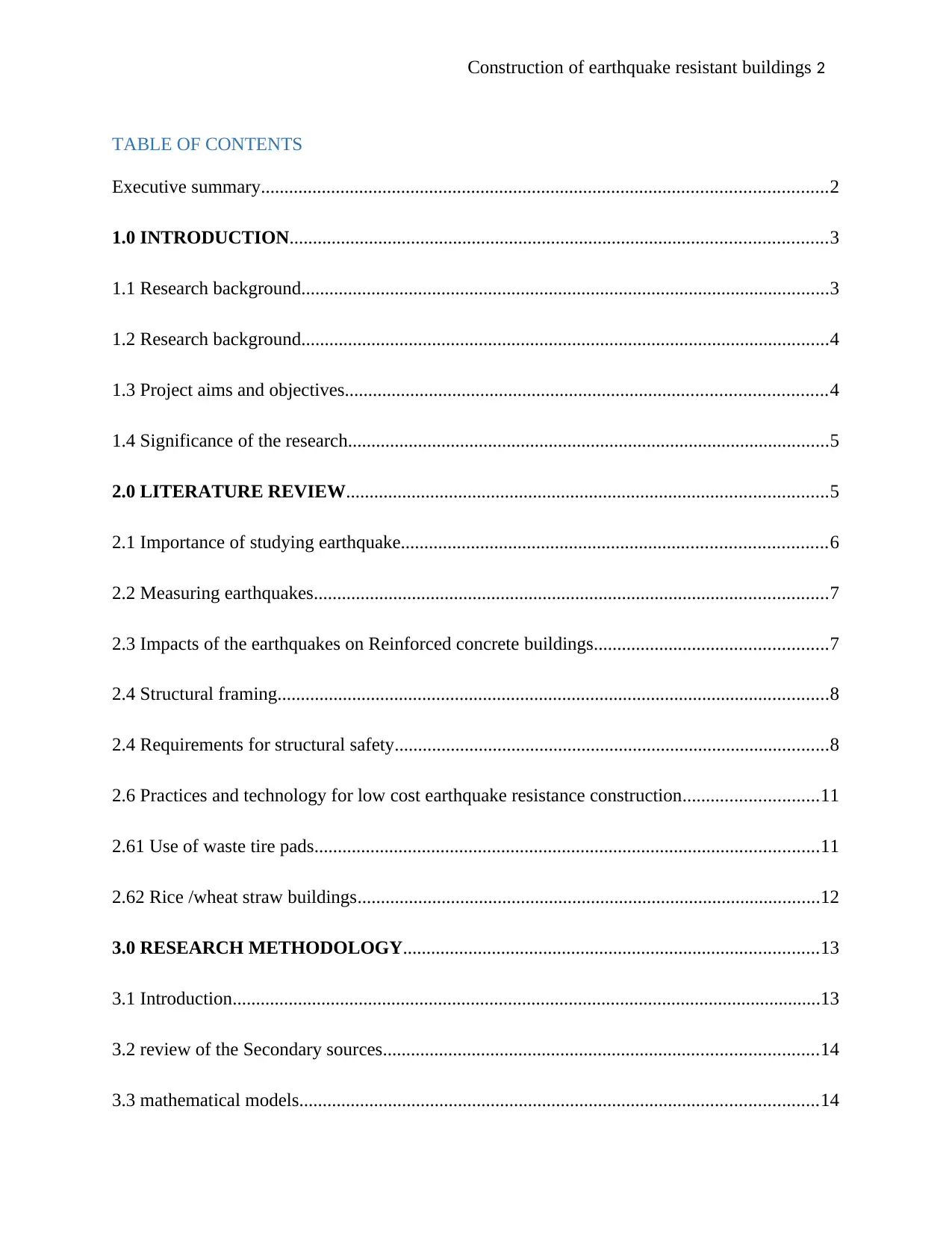
Construction of earthquake resistant buildings 2
TABLE OF CONTENTS
Executive summary.........................................................................................................................2
1.0 INTRODUCTION...................................................................................................................3
1.1 Research background.................................................................................................................3
1.2 Research background.................................................................................................................4
1.3 Project aims and objectives.......................................................................................................4
1.4 Significance of the research.......................................................................................................5
2.0 LITERATURE REVIEW.......................................................................................................5
2.1 Importance of studying earthquake...........................................................................................6
2.2 Measuring earthquakes..............................................................................................................7
2.3 Impacts of the earthquakes on Reinforced concrete buildings..................................................7
2.4 Structural framing......................................................................................................................8
2.4 Requirements for structural safety.............................................................................................8
2.6 Practices and technology for low cost earthquake resistance construction.............................11
2.61 Use of waste tire pads............................................................................................................11
2.62 Rice /wheat straw buildings...................................................................................................12
3.0 RESEARCH METHODOLOGY.........................................................................................13
3.1 Introduction..............................................................................................................................13
3.2 review of the Secondary sources.............................................................................................14
3.3 mathematical models...............................................................................................................14
TABLE OF CONTENTS
Executive summary.........................................................................................................................2
1.0 INTRODUCTION...................................................................................................................3
1.1 Research background.................................................................................................................3
1.2 Research background.................................................................................................................4
1.3 Project aims and objectives.......................................................................................................4
1.4 Significance of the research.......................................................................................................5
2.0 LITERATURE REVIEW.......................................................................................................5
2.1 Importance of studying earthquake...........................................................................................6
2.2 Measuring earthquakes..............................................................................................................7
2.3 Impacts of the earthquakes on Reinforced concrete buildings..................................................7
2.4 Structural framing......................................................................................................................8
2.4 Requirements for structural safety.............................................................................................8
2.6 Practices and technology for low cost earthquake resistance construction.............................11
2.61 Use of waste tire pads............................................................................................................11
2.62 Rice /wheat straw buildings...................................................................................................12
3.0 RESEARCH METHODOLOGY.........................................................................................13
3.1 Introduction..............................................................................................................................13
3.2 review of the Secondary sources.............................................................................................14
3.3 mathematical models...............................................................................................................14
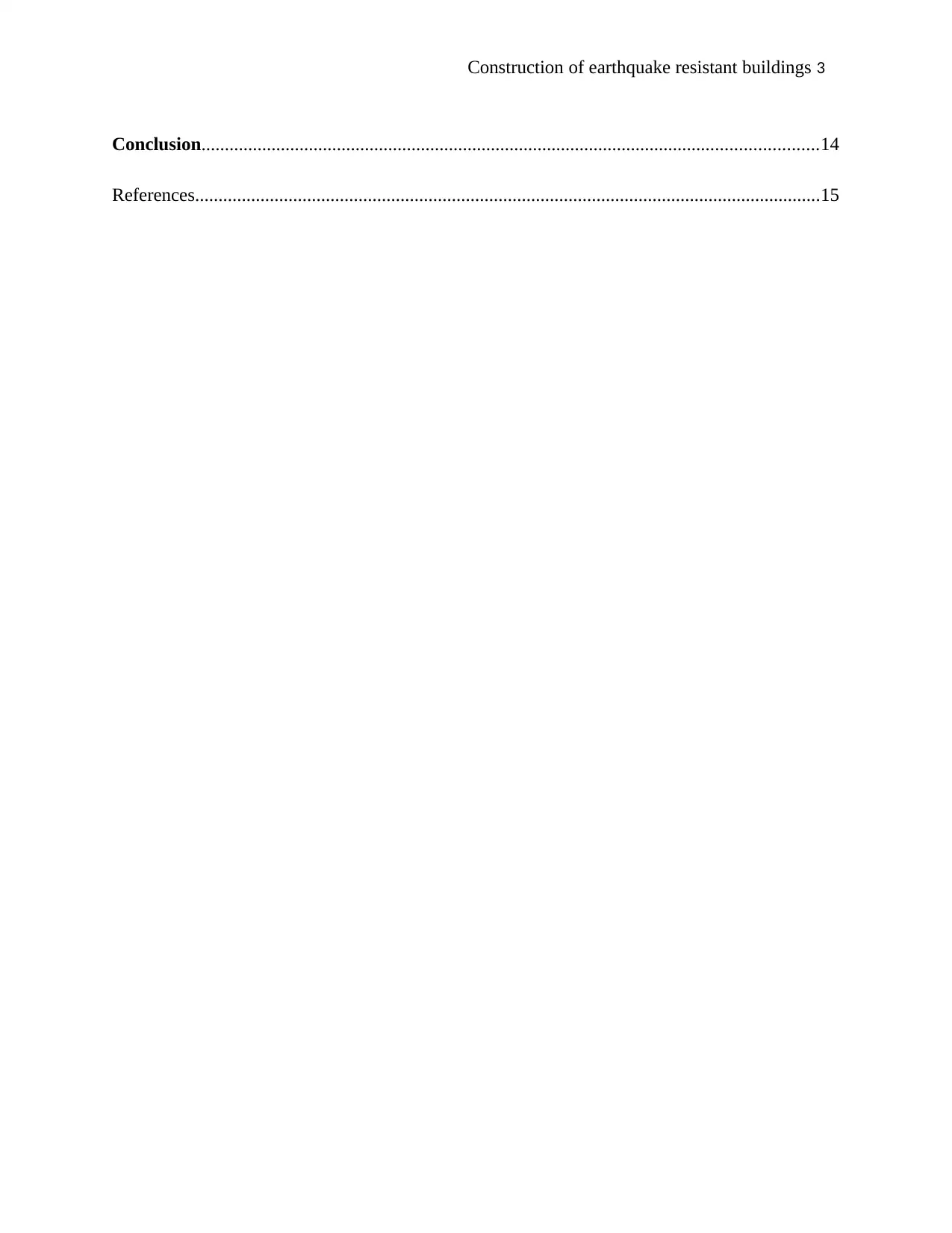
Construction of earthquake resistant buildings 3
Conclusion....................................................................................................................................14
References......................................................................................................................................15
Conclusion....................................................................................................................................14
References......................................................................................................................................15
⊘ This is a preview!⊘
Do you want full access?
Subscribe today to unlock all pages.

Trusted by 1+ million students worldwide
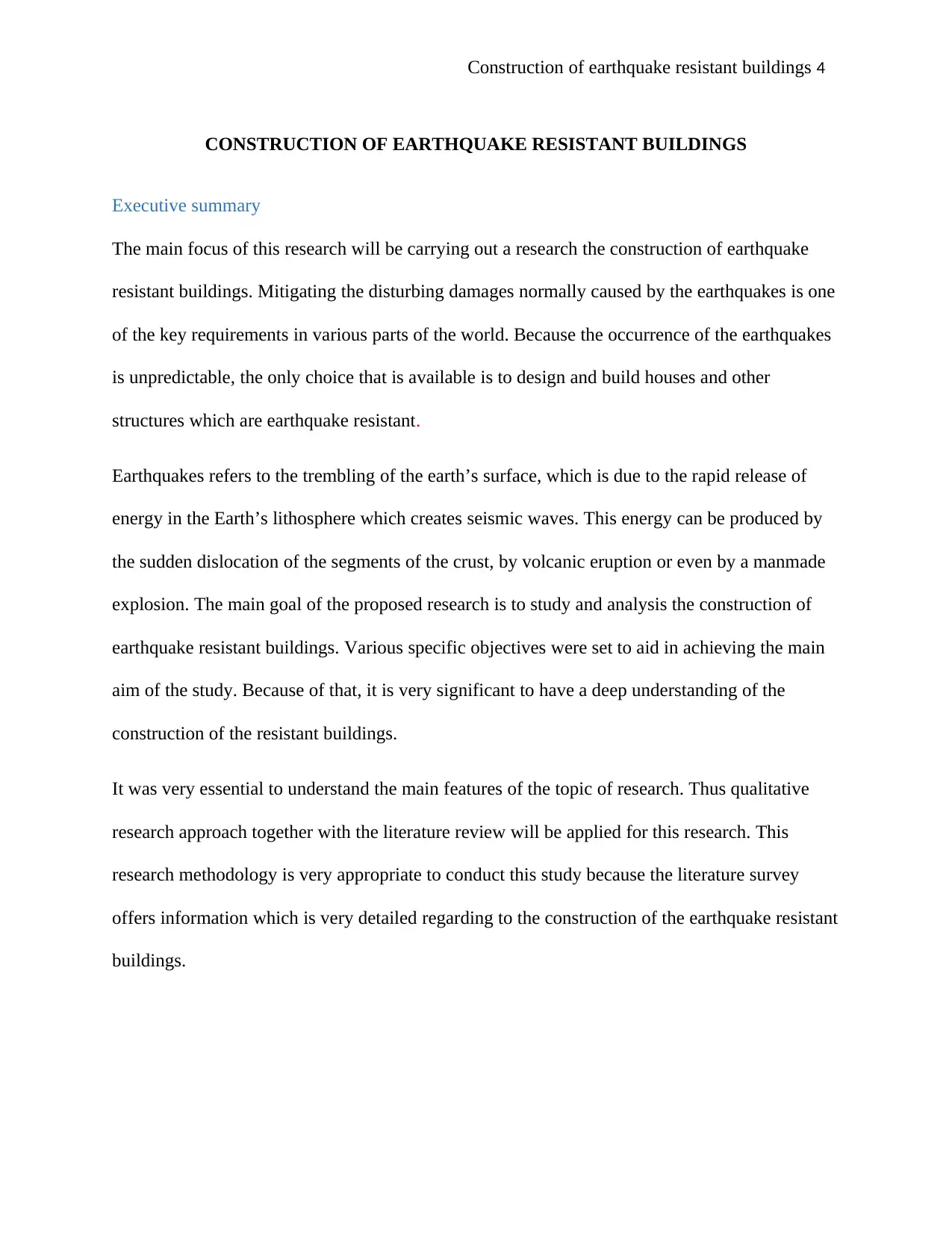
Construction of earthquake resistant buildings 4
CONSTRUCTION OF EARTHQUAKE RESISTANT BUILDINGS
Executive summary
The main focus of this research will be carrying out a research the construction of earthquake
resistant buildings. Mitigating the disturbing damages normally caused by the earthquakes is one
of the key requirements in various parts of the world. Because the occurrence of the earthquakes
is unpredictable, the only choice that is available is to design and build houses and other
structures which are earthquake resistant.
Earthquakes refers to the trembling of the earth’s surface, which is due to the rapid release of
energy in the Earth’s lithosphere which creates seismic waves. This energy can be produced by
the sudden dislocation of the segments of the crust, by volcanic eruption or even by a manmade
explosion. The main goal of the proposed research is to study and analysis the construction of
earthquake resistant buildings. Various specific objectives were set to aid in achieving the main
aim of the study. Because of that, it is very significant to have a deep understanding of the
construction of the resistant buildings.
It was very essential to understand the main features of the topic of research. Thus qualitative
research approach together with the literature review will be applied for this research. This
research methodology is very appropriate to conduct this study because the literature survey
offers information which is very detailed regarding to the construction of the earthquake resistant
buildings.
CONSTRUCTION OF EARTHQUAKE RESISTANT BUILDINGS
Executive summary
The main focus of this research will be carrying out a research the construction of earthquake
resistant buildings. Mitigating the disturbing damages normally caused by the earthquakes is one
of the key requirements in various parts of the world. Because the occurrence of the earthquakes
is unpredictable, the only choice that is available is to design and build houses and other
structures which are earthquake resistant.
Earthquakes refers to the trembling of the earth’s surface, which is due to the rapid release of
energy in the Earth’s lithosphere which creates seismic waves. This energy can be produced by
the sudden dislocation of the segments of the crust, by volcanic eruption or even by a manmade
explosion. The main goal of the proposed research is to study and analysis the construction of
earthquake resistant buildings. Various specific objectives were set to aid in achieving the main
aim of the study. Because of that, it is very significant to have a deep understanding of the
construction of the resistant buildings.
It was very essential to understand the main features of the topic of research. Thus qualitative
research approach together with the literature review will be applied for this research. This
research methodology is very appropriate to conduct this study because the literature survey
offers information which is very detailed regarding to the construction of the earthquake resistant
buildings.
Paraphrase This Document
Need a fresh take? Get an instant paraphrase of this document with our AI Paraphraser
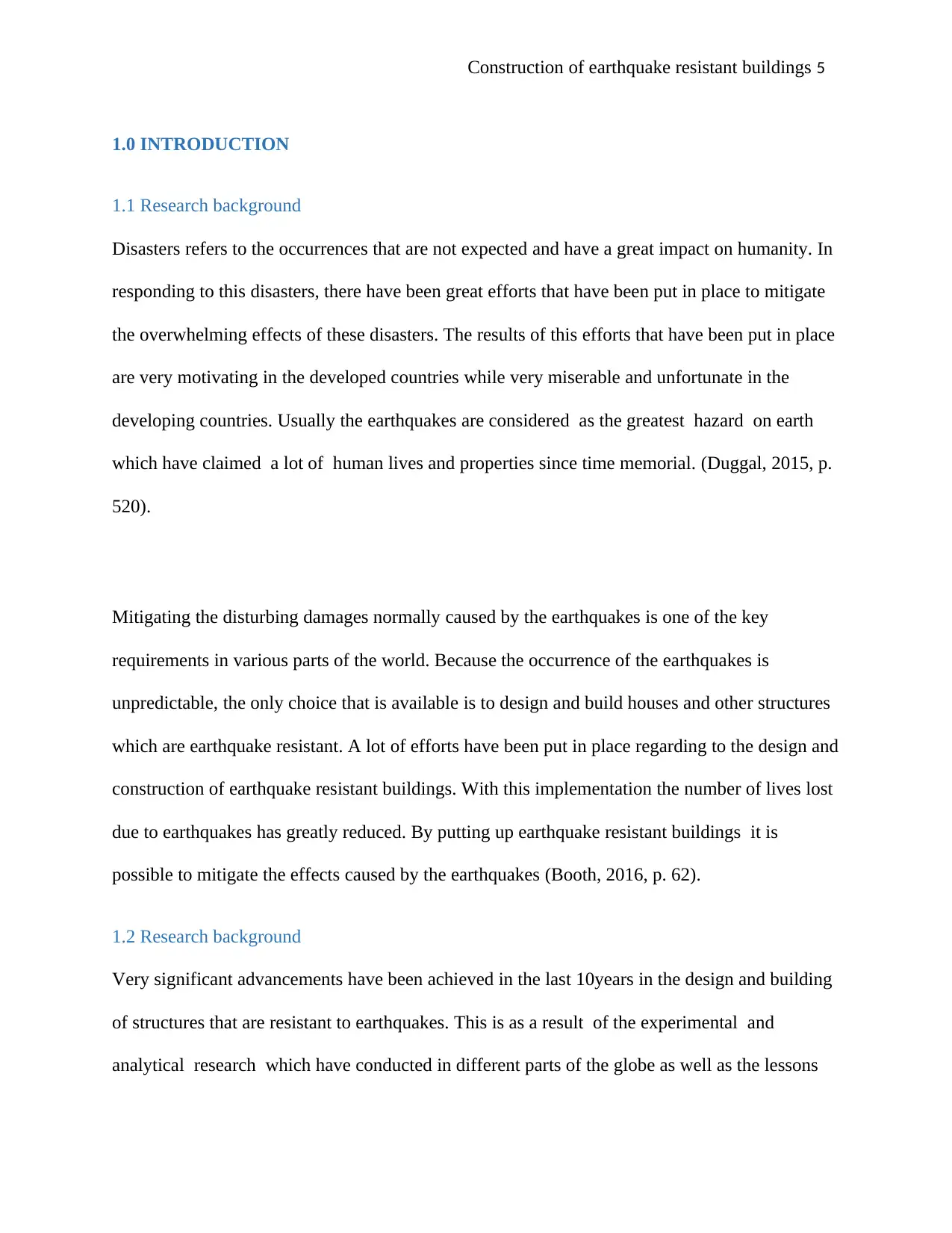
Construction of earthquake resistant buildings 5
1.0 INTRODUCTION
1.1 Research background
Disasters refers to the occurrences that are not expected and have a great impact on humanity. In
responding to this disasters, there have been great efforts that have been put in place to mitigate
the overwhelming effects of these disasters. The results of this efforts that have been put in place
are very motivating in the developed countries while very miserable and unfortunate in the
developing countries. Usually the earthquakes are considered as the greatest hazard on earth
which have claimed a lot of human lives and properties since time memorial. (Duggal, 2015, p.
520).
Mitigating the disturbing damages normally caused by the earthquakes is one of the key
requirements in various parts of the world. Because the occurrence of the earthquakes is
unpredictable, the only choice that is available is to design and build houses and other structures
which are earthquake resistant. A lot of efforts have been put in place regarding to the design and
construction of earthquake resistant buildings. With this implementation the number of lives lost
due to earthquakes has greatly reduced. By putting up earthquake resistant buildings it is
possible to mitigate the effects caused by the earthquakes (Booth, 2016, p. 62).
1.2 Research background
Very significant advancements have been achieved in the last 10years in the design and building
of structures that are resistant to earthquakes. This is as a result of the experimental and
analytical research which have conducted in different parts of the globe as well as the lessons
1.0 INTRODUCTION
1.1 Research background
Disasters refers to the occurrences that are not expected and have a great impact on humanity. In
responding to this disasters, there have been great efforts that have been put in place to mitigate
the overwhelming effects of these disasters. The results of this efforts that have been put in place
are very motivating in the developed countries while very miserable and unfortunate in the
developing countries. Usually the earthquakes are considered as the greatest hazard on earth
which have claimed a lot of human lives and properties since time memorial. (Duggal, 2015, p.
520).
Mitigating the disturbing damages normally caused by the earthquakes is one of the key
requirements in various parts of the world. Because the occurrence of the earthquakes is
unpredictable, the only choice that is available is to design and build houses and other structures
which are earthquake resistant. A lot of efforts have been put in place regarding to the design and
construction of earthquake resistant buildings. With this implementation the number of lives lost
due to earthquakes has greatly reduced. By putting up earthquake resistant buildings it is
possible to mitigate the effects caused by the earthquakes (Booth, 2016, p. 62).
1.2 Research background
Very significant advancements have been achieved in the last 10years in the design and building
of structures that are resistant to earthquakes. This is as a result of the experimental and
analytical research which have conducted in different parts of the globe as well as the lessons
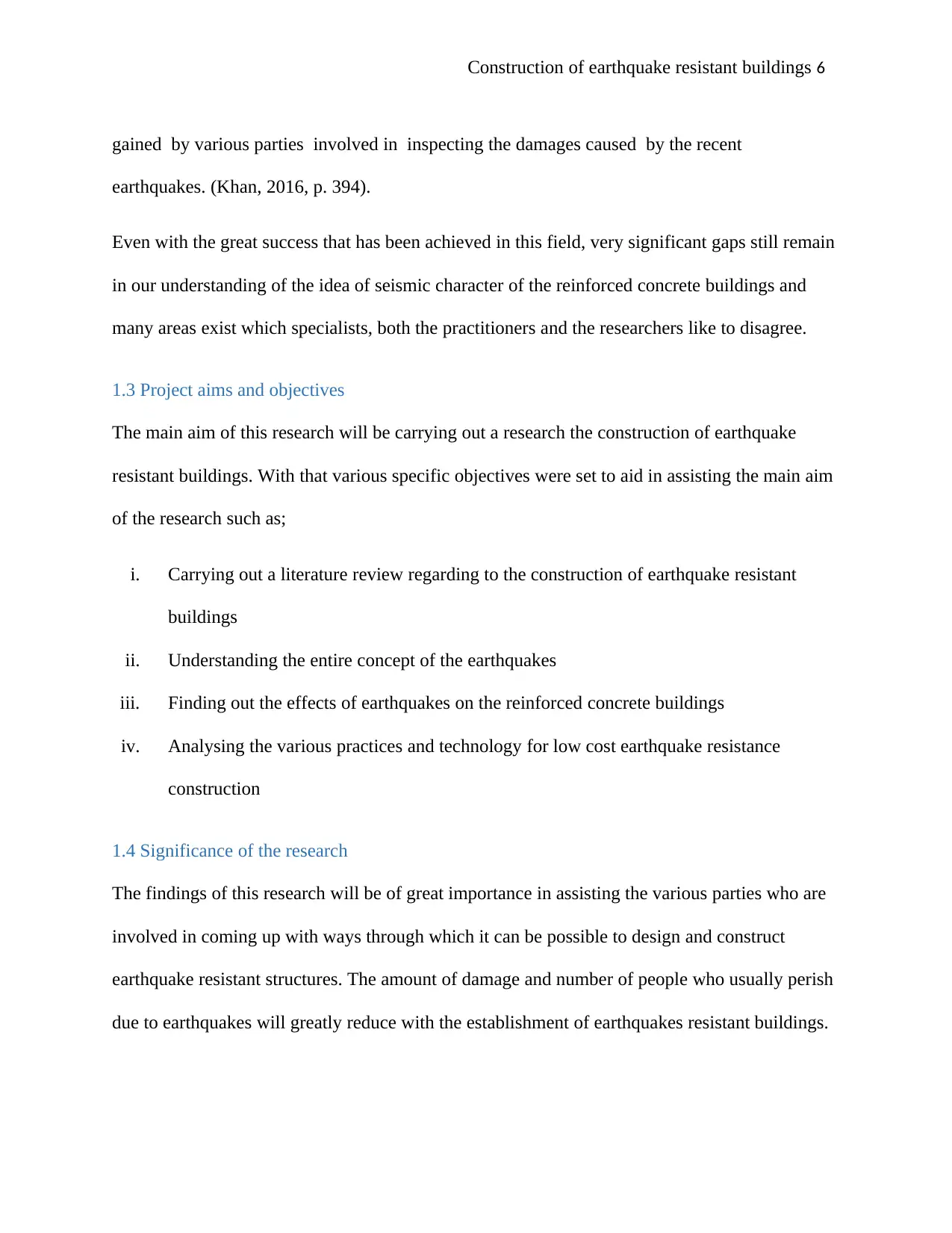
Construction of earthquake resistant buildings 6
gained by various parties involved in inspecting the damages caused by the recent
earthquakes. (Khan, 2016, p. 394).
Even with the great success that has been achieved in this field, very significant gaps still remain
in our understanding of the idea of seismic character of the reinforced concrete buildings and
many areas exist which specialists, both the practitioners and the researchers like to disagree.
1.3 Project aims and objectives
The main aim of this research will be carrying out a research the construction of earthquake
resistant buildings. With that various specific objectives were set to aid in assisting the main aim
of the research such as;
i. Carrying out a literature review regarding to the construction of earthquake resistant
buildings
ii. Understanding the entire concept of the earthquakes
iii. Finding out the effects of earthquakes on the reinforced concrete buildings
iv. Analysing the various practices and technology for low cost earthquake resistance
construction
1.4 Significance of the research
The findings of this research will be of great importance in assisting the various parties who are
involved in coming up with ways through which it can be possible to design and construct
earthquake resistant structures. The amount of damage and number of people who usually perish
due to earthquakes will greatly reduce with the establishment of earthquakes resistant buildings.
gained by various parties involved in inspecting the damages caused by the recent
earthquakes. (Khan, 2016, p. 394).
Even with the great success that has been achieved in this field, very significant gaps still remain
in our understanding of the idea of seismic character of the reinforced concrete buildings and
many areas exist which specialists, both the practitioners and the researchers like to disagree.
1.3 Project aims and objectives
The main aim of this research will be carrying out a research the construction of earthquake
resistant buildings. With that various specific objectives were set to aid in assisting the main aim
of the research such as;
i. Carrying out a literature review regarding to the construction of earthquake resistant
buildings
ii. Understanding the entire concept of the earthquakes
iii. Finding out the effects of earthquakes on the reinforced concrete buildings
iv. Analysing the various practices and technology for low cost earthquake resistance
construction
1.4 Significance of the research
The findings of this research will be of great importance in assisting the various parties who are
involved in coming up with ways through which it can be possible to design and construct
earthquake resistant structures. The amount of damage and number of people who usually perish
due to earthquakes will greatly reduce with the establishment of earthquakes resistant buildings.
⊘ This is a preview!⊘
Do you want full access?
Subscribe today to unlock all pages.

Trusted by 1+ million students worldwide
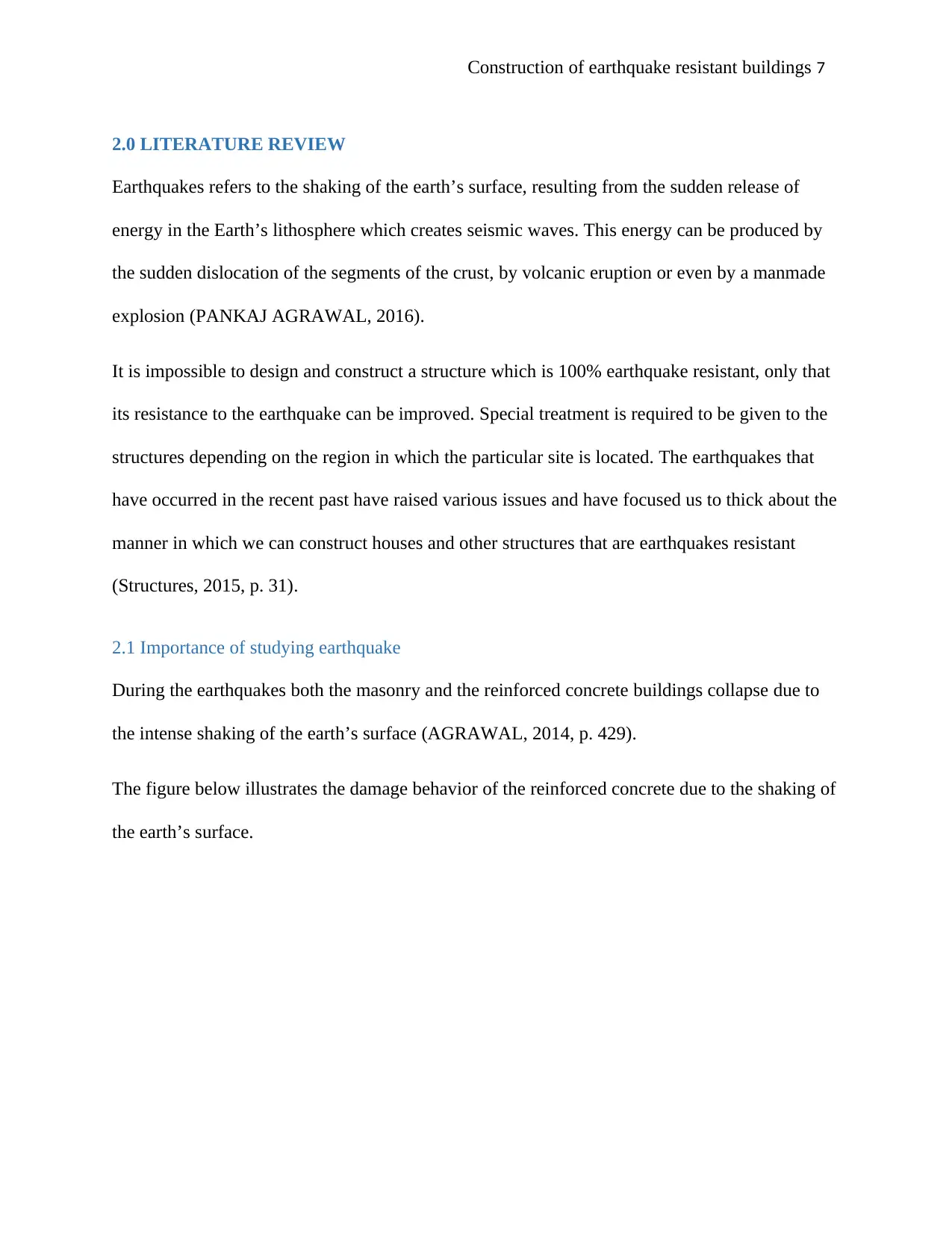
Construction of earthquake resistant buildings 7
2.0 LITERATURE REVIEW
Earthquakes refers to the shaking of the earth’s surface, resulting from the sudden release of
energy in the Earth’s lithosphere which creates seismic waves. This energy can be produced by
the sudden dislocation of the segments of the crust, by volcanic eruption or even by a manmade
explosion (PANKAJ AGRAWAL, 2016).
It is impossible to design and construct a structure which is 100% earthquake resistant, only that
its resistance to the earthquake can be improved. Special treatment is required to be given to the
structures depending on the region in which the particular site is located. The earthquakes that
have occurred in the recent past have raised various issues and have focused us to thick about the
manner in which we can construct houses and other structures that are earthquakes resistant
(Structures, 2015, p. 31).
2.1 Importance of studying earthquake
During the earthquakes both the masonry and the reinforced concrete buildings collapse due to
the intense shaking of the earth’s surface (AGRAWAL, 2014, p. 429).
The figure below illustrates the damage behavior of the reinforced concrete due to the shaking of
the earth’s surface.
2.0 LITERATURE REVIEW
Earthquakes refers to the shaking of the earth’s surface, resulting from the sudden release of
energy in the Earth’s lithosphere which creates seismic waves. This energy can be produced by
the sudden dislocation of the segments of the crust, by volcanic eruption or even by a manmade
explosion (PANKAJ AGRAWAL, 2016).
It is impossible to design and construct a structure which is 100% earthquake resistant, only that
its resistance to the earthquake can be improved. Special treatment is required to be given to the
structures depending on the region in which the particular site is located. The earthquakes that
have occurred in the recent past have raised various issues and have focused us to thick about the
manner in which we can construct houses and other structures that are earthquakes resistant
(Structures, 2015, p. 31).
2.1 Importance of studying earthquake
During the earthquakes both the masonry and the reinforced concrete buildings collapse due to
the intense shaking of the earth’s surface (AGRAWAL, 2014, p. 429).
The figure below illustrates the damage behavior of the reinforced concrete due to the shaking of
the earth’s surface.
Paraphrase This Document
Need a fresh take? Get an instant paraphrase of this document with our AI Paraphraser
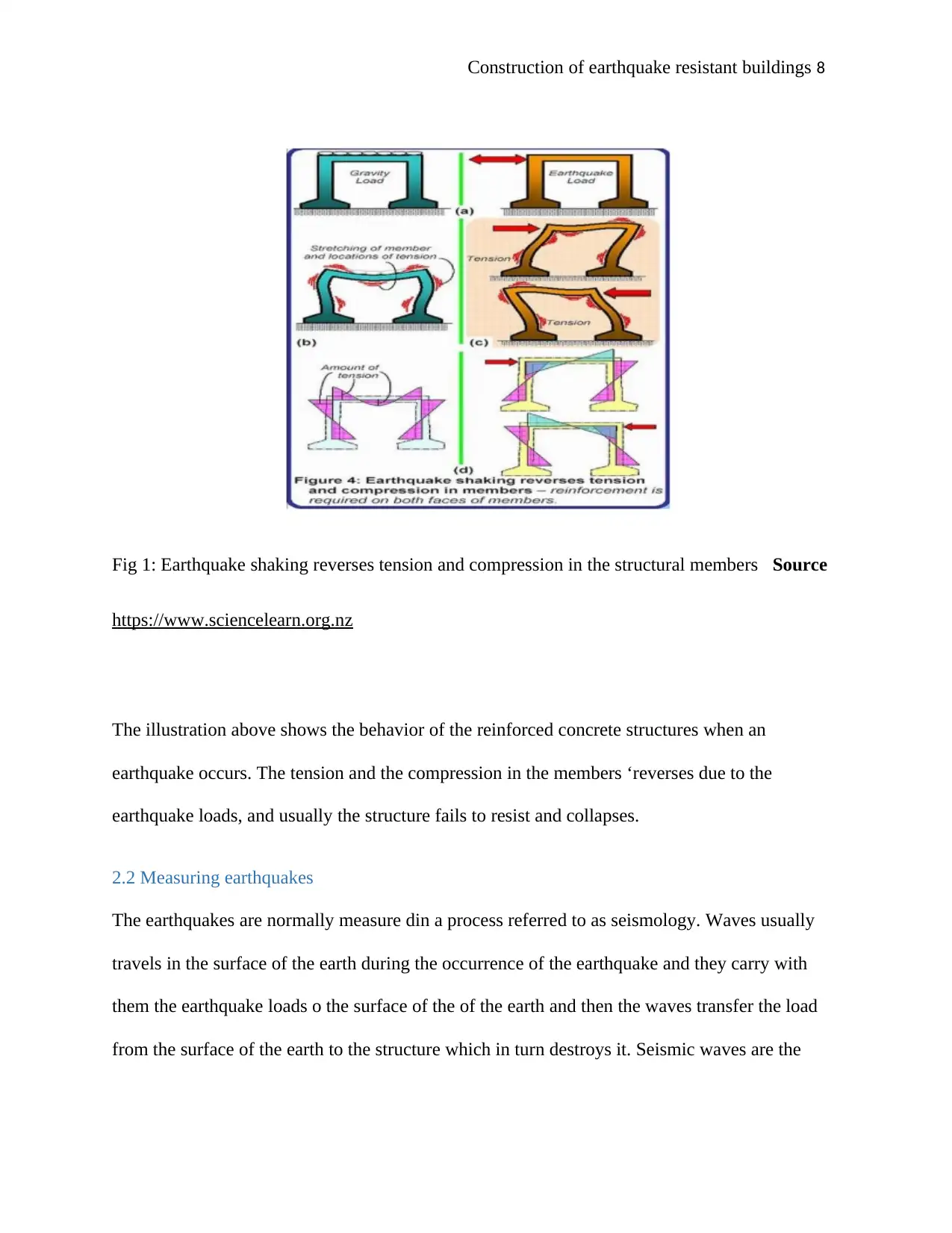
Construction of earthquake resistant buildings 8
Fig 1: Earthquake shaking reverses tension and compression in the structural members Source
https://www.sciencelearn.org.nz
The illustration above shows the behavior of the reinforced concrete structures when an
earthquake occurs. The tension and the compression in the members ‘reverses due to the
earthquake loads, and usually the structure fails to resist and collapses.
2.2 Measuring earthquakes
The earthquakes are normally measure din a process referred to as seismology. Waves usually
travels in the surface of the earth during the occurrence of the earthquake and they carry with
them the earthquake loads o the surface of the of the earth and then the waves transfer the load
from the surface of the earth to the structure which in turn destroys it. Seismic waves are the
Fig 1: Earthquake shaking reverses tension and compression in the structural members Source
https://www.sciencelearn.org.nz
The illustration above shows the behavior of the reinforced concrete structures when an
earthquake occurs. The tension and the compression in the members ‘reverses due to the
earthquake loads, and usually the structure fails to resist and collapses.
2.2 Measuring earthquakes
The earthquakes are normally measure din a process referred to as seismology. Waves usually
travels in the surface of the earth during the occurrence of the earthquake and they carry with
them the earthquake loads o the surface of the of the earth and then the waves transfer the load
from the surface of the earth to the structure which in turn destroys it. Seismic waves are the
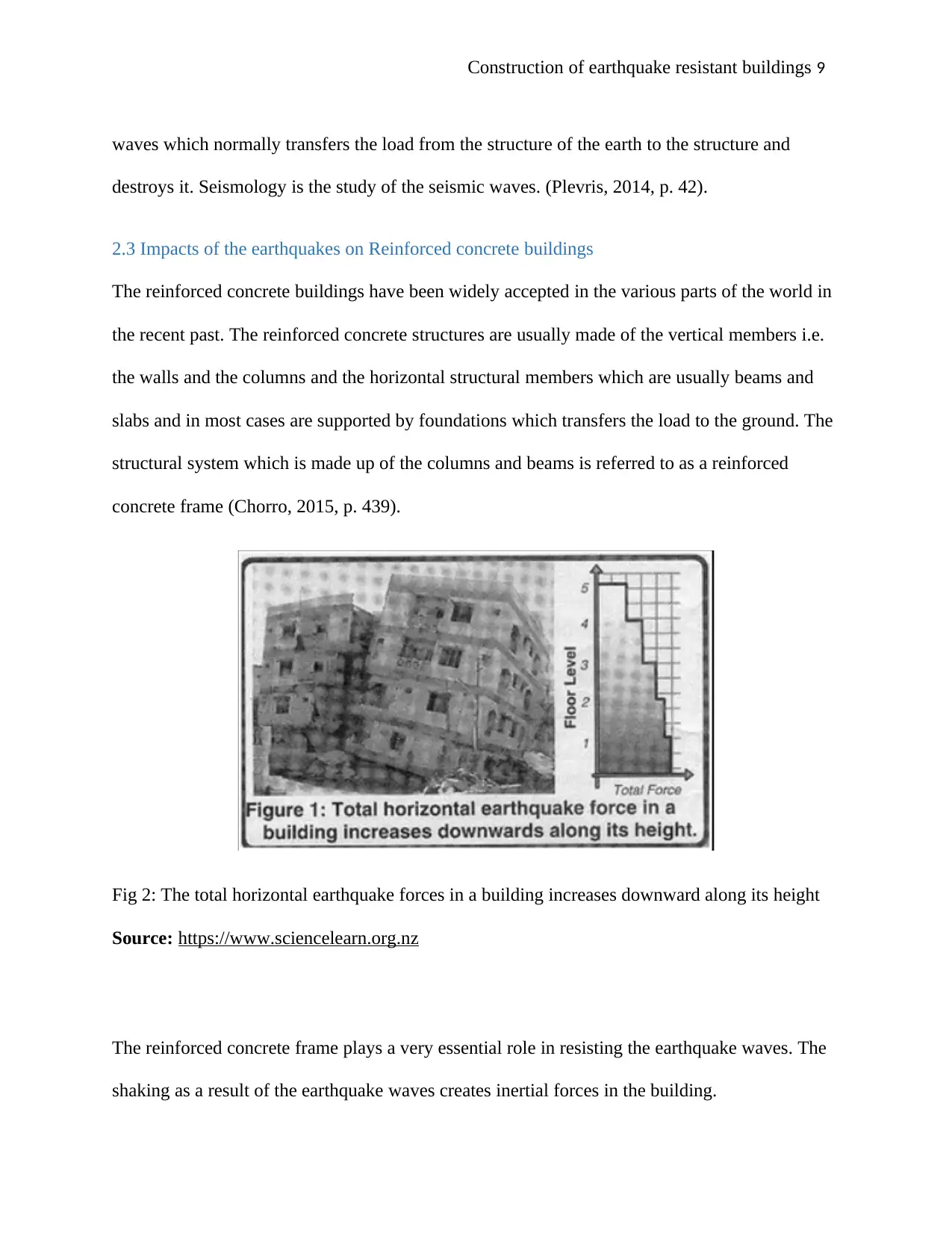
Construction of earthquake resistant buildings 9
waves which normally transfers the load from the structure of the earth to the structure and
destroys it. Seismology is the study of the seismic waves. (Plevris, 2014, p. 42).
2.3 Impacts of the earthquakes on Reinforced concrete buildings
The reinforced concrete buildings have been widely accepted in the various parts of the world in
the recent past. The reinforced concrete structures are usually made of the vertical members i.e.
the walls and the columns and the horizontal structural members which are usually beams and
slabs and in most cases are supported by foundations which transfers the load to the ground. The
structural system which is made up of the columns and beams is referred to as a reinforced
concrete frame (Chorro, 2015, p. 439).
Fig 2: The total horizontal earthquake forces in a building increases downward along its height
Source: https://www.sciencelearn.org.nz
The reinforced concrete frame plays a very essential role in resisting the earthquake waves. The
shaking as a result of the earthquake waves creates inertial forces in the building.
waves which normally transfers the load from the structure of the earth to the structure and
destroys it. Seismology is the study of the seismic waves. (Plevris, 2014, p. 42).
2.3 Impacts of the earthquakes on Reinforced concrete buildings
The reinforced concrete buildings have been widely accepted in the various parts of the world in
the recent past. The reinforced concrete structures are usually made of the vertical members i.e.
the walls and the columns and the horizontal structural members which are usually beams and
slabs and in most cases are supported by foundations which transfers the load to the ground. The
structural system which is made up of the columns and beams is referred to as a reinforced
concrete frame (Chorro, 2015, p. 439).
Fig 2: The total horizontal earthquake forces in a building increases downward along its height
Source: https://www.sciencelearn.org.nz
The reinforced concrete frame plays a very essential role in resisting the earthquake waves. The
shaking as a result of the earthquake waves creates inertial forces in the building.
⊘ This is a preview!⊘
Do you want full access?
Subscribe today to unlock all pages.

Trusted by 1+ million students worldwide
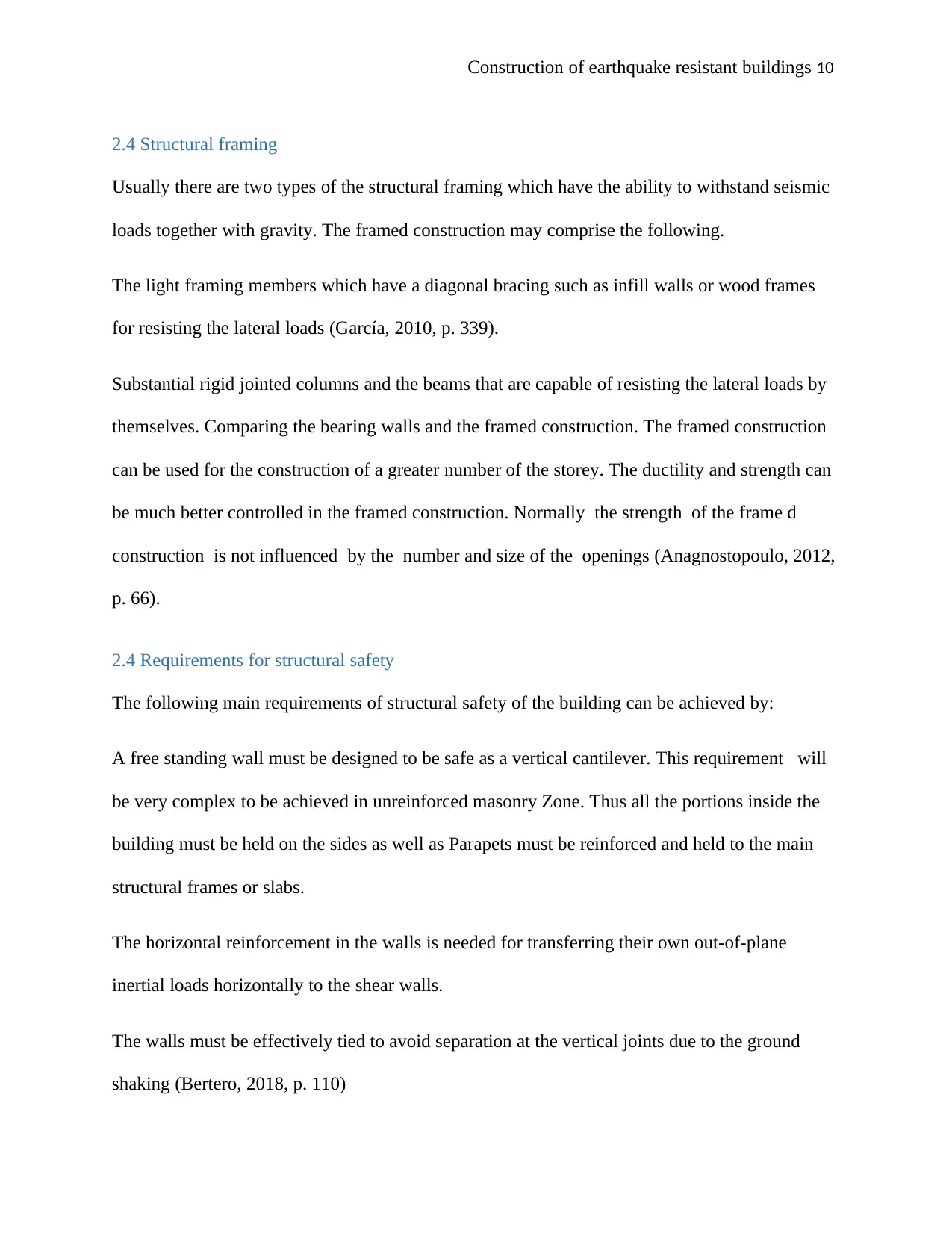
Construction of earthquake resistant buildings 10
2.4 Structural framing
Usually there are two types of the structural framing which have the ability to withstand seismic
loads together with gravity. The framed construction may comprise the following.
The light framing members which have a diagonal bracing such as infill walls or wood frames
for resisting the lateral loads (García, 2010, p. 339).
Substantial rigid jointed columns and the beams that are capable of resisting the lateral loads by
themselves. Comparing the bearing walls and the framed construction. The framed construction
can be used for the construction of a greater number of the storey. The ductility and strength can
be much better controlled in the framed construction. Normally the strength of the frame d
construction is not influenced by the number and size of the openings (Anagnostopoulo, 2012,
p. 66).
2.4 Requirements for structural safety
The following main requirements of structural safety of the building can be achieved by:
A free standing wall must be designed to be safe as a vertical cantilever. This requirement will
be very complex to be achieved in unreinforced masonry Zone. Thus all the portions inside the
building must be held on the sides as well as Parapets must be reinforced and held to the main
structural frames or slabs.
The horizontal reinforcement in the walls is needed for transferring their own out-of-plane
inertial loads horizontally to the shear walls.
The walls must be effectively tied to avoid separation at the vertical joints due to the ground
shaking (Bertero, 2018, p. 110)
2.4 Structural framing
Usually there are two types of the structural framing which have the ability to withstand seismic
loads together with gravity. The framed construction may comprise the following.
The light framing members which have a diagonal bracing such as infill walls or wood frames
for resisting the lateral loads (García, 2010, p. 339).
Substantial rigid jointed columns and the beams that are capable of resisting the lateral loads by
themselves. Comparing the bearing walls and the framed construction. The framed construction
can be used for the construction of a greater number of the storey. The ductility and strength can
be much better controlled in the framed construction. Normally the strength of the frame d
construction is not influenced by the number and size of the openings (Anagnostopoulo, 2012,
p. 66).
2.4 Requirements for structural safety
The following main requirements of structural safety of the building can be achieved by:
A free standing wall must be designed to be safe as a vertical cantilever. This requirement will
be very complex to be achieved in unreinforced masonry Zone. Thus all the portions inside the
building must be held on the sides as well as Parapets must be reinforced and held to the main
structural frames or slabs.
The horizontal reinforcement in the walls is needed for transferring their own out-of-plane
inertial loads horizontally to the shear walls.
The walls must be effectively tied to avoid separation at the vertical joints due to the ground
shaking (Bertero, 2018, p. 110)
Paraphrase This Document
Need a fresh take? Get an instant paraphrase of this document with our AI Paraphraser
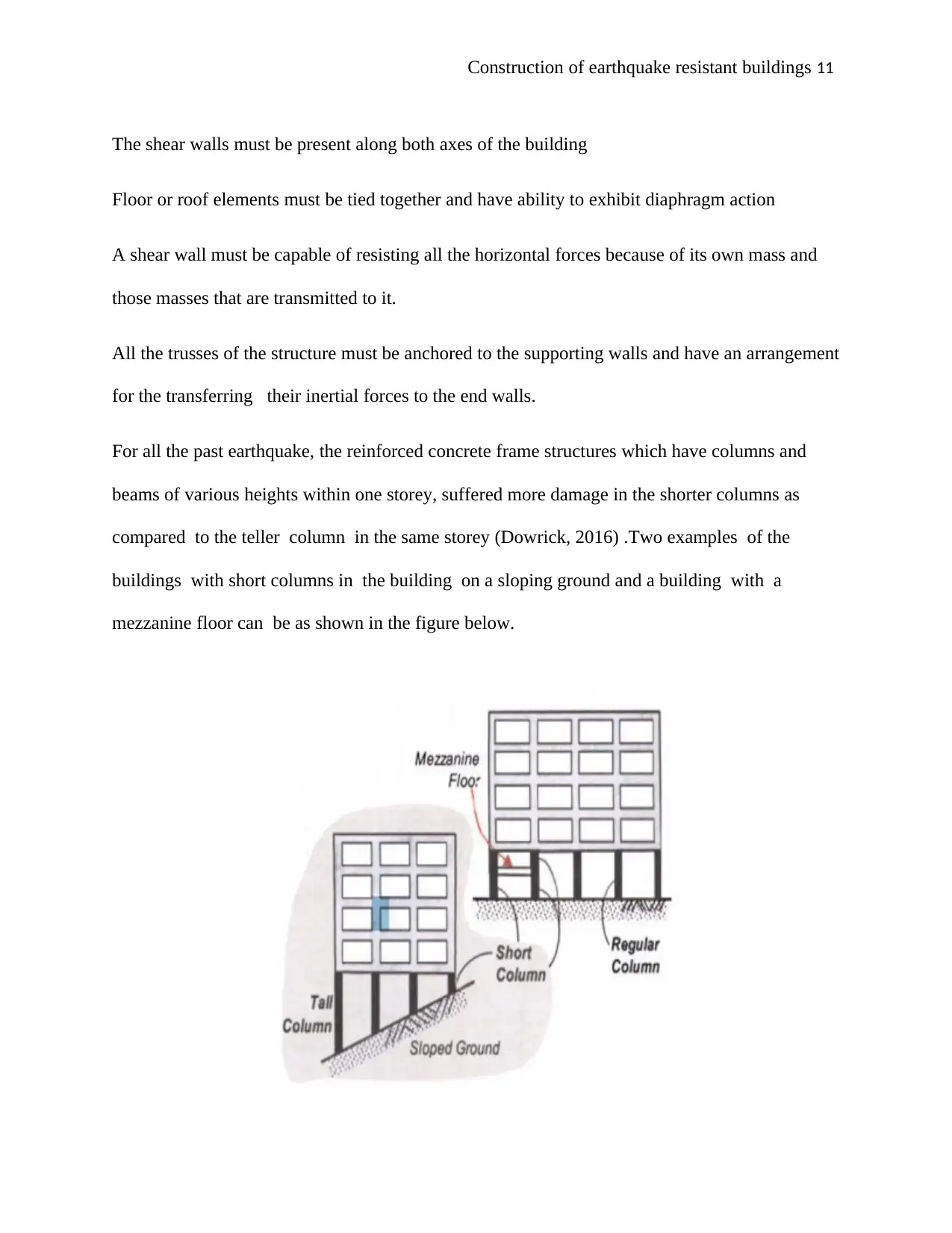
Construction of earthquake resistant buildings 11
The shear walls must be present along both axes of the building
Floor or roof elements must be tied together and have ability to exhibit diaphragm action
A shear wall must be capable of resisting all the horizontal forces because of its own mass and
those masses that are transmitted to it.
All the trusses of the structure must be anchored to the supporting walls and have an arrangement
for the transferring their inertial forces to the end walls.
For all the past earthquake, the reinforced concrete frame structures which have columns and
beams of various heights within one storey, suffered more damage in the shorter columns as
compared to the teller column in the same storey (Dowrick, 2016) .Two examples of the
buildings with short columns in the building on a sloping ground and a building with a
mezzanine floor can be as shown in the figure below.
The shear walls must be present along both axes of the building
Floor or roof elements must be tied together and have ability to exhibit diaphragm action
A shear wall must be capable of resisting all the horizontal forces because of its own mass and
those masses that are transmitted to it.
All the trusses of the structure must be anchored to the supporting walls and have an arrangement
for the transferring their inertial forces to the end walls.
For all the past earthquake, the reinforced concrete frame structures which have columns and
beams of various heights within one storey, suffered more damage in the shorter columns as
compared to the teller column in the same storey (Dowrick, 2016) .Two examples of the
buildings with short columns in the building on a sloping ground and a building with a
mezzanine floor can be as shown in the figure below.
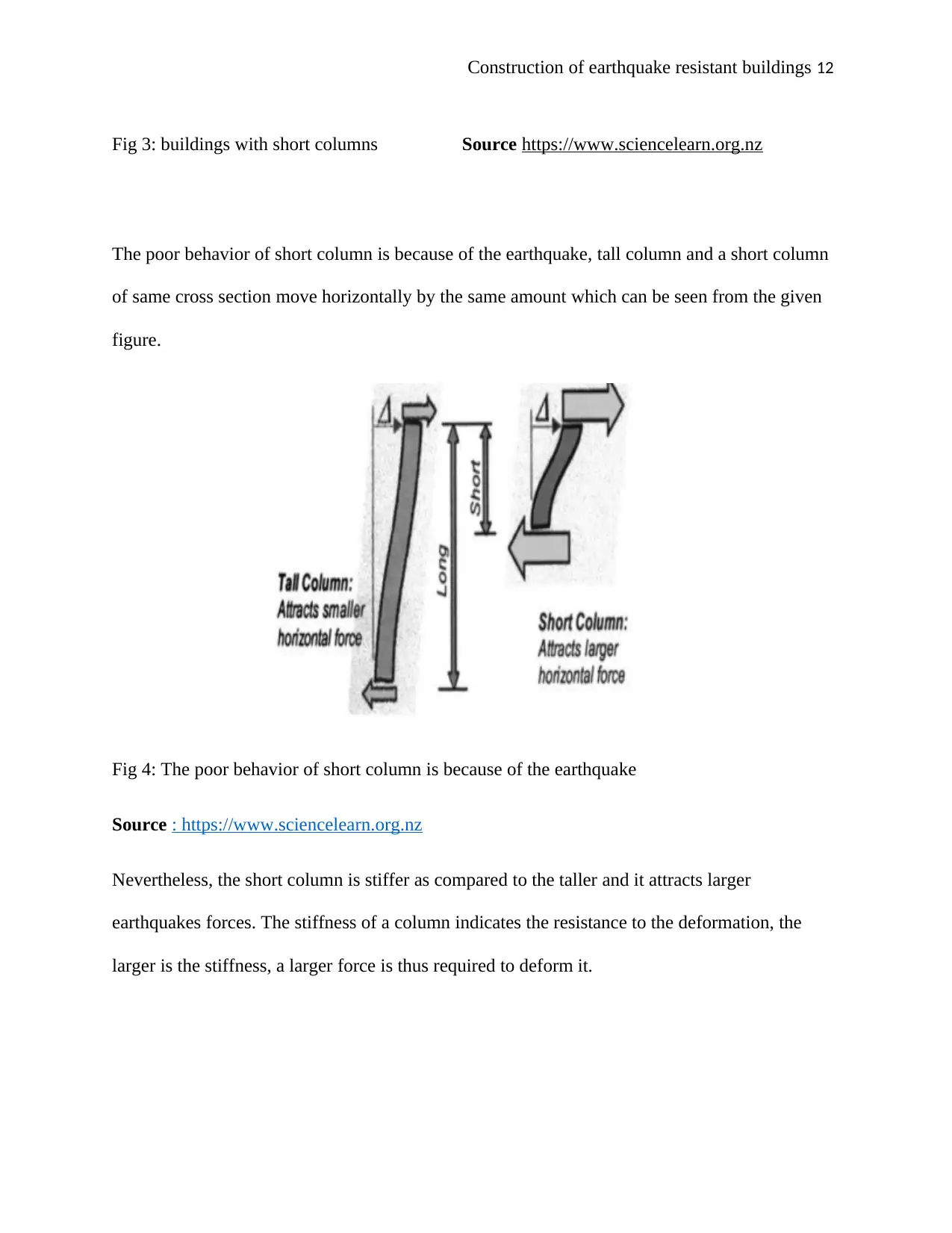
Construction of earthquake resistant buildings 12
Fig 3: buildings with short columns Source https://www.sciencelearn.org.nz
The poor behavior of short column is because of the earthquake, tall column and a short column
of same cross section move horizontally by the same amount which can be seen from the given
figure.
Fig 4: The poor behavior of short column is because of the earthquake
Source : https://www.sciencelearn.org.nz
Nevertheless, the short column is stiffer as compared to the taller and it attracts larger
earthquakes forces. The stiffness of a column indicates the resistance to the deformation, the
larger is the stiffness, a larger force is thus required to deform it.
Fig 3: buildings with short columns Source https://www.sciencelearn.org.nz
The poor behavior of short column is because of the earthquake, tall column and a short column
of same cross section move horizontally by the same amount which can be seen from the given
figure.
Fig 4: The poor behavior of short column is because of the earthquake
Source : https://www.sciencelearn.org.nz
Nevertheless, the short column is stiffer as compared to the taller and it attracts larger
earthquakes forces. The stiffness of a column indicates the resistance to the deformation, the
larger is the stiffness, a larger force is thus required to deform it.
⊘ This is a preview!⊘
Do you want full access?
Subscribe today to unlock all pages.

Trusted by 1+ million students worldwide
1 out of 19
Related Documents
Your All-in-One AI-Powered Toolkit for Academic Success.
+13062052269
info@desklib.com
Available 24*7 on WhatsApp / Email
![[object Object]](/_next/static/media/star-bottom.7253800d.svg)
Unlock your academic potential
Copyright © 2020–2025 A2Z Services. All Rights Reserved. Developed and managed by ZUCOL.




